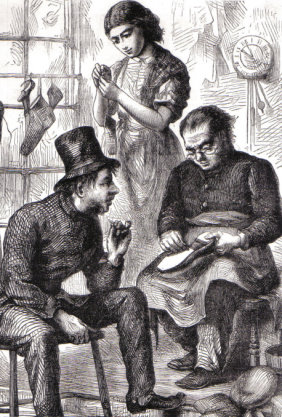| |
| |
|
|
|
| |
| |
"BY MAKING 4 PAIR OF SMALL SHOES" --
THE COBBLER
Starting in 1782, the area had a full-time cobbler,
John Delong. His account page in the Dupui general
store ledger is replete with shoe-making entries:
-- By making 12 pair of Shoes
-- By soaling 3
pair shoes
-- By making 4 Pair of small shoes
-- By upper leather for 2 pair of Shoes
-- By making 1 pair of womens shoes
-- By making
1 pair of Shoes and Soal leather for the same and 1
pair of small shoes
Making a new pair of shoes was not an overly costly
proposition (with Delong charging as little as 3
shillings for the service). If all you needed was
to have new soles put on, the cobbler would charge a
mere shilling for the work. But these were just the
labor charges... one still needed to supply the
cobbler with the desired material for the shoes,
which could have been anything from callamancoe to
"upper leather for 2 pair of Shoes." The upper
leather would have cost around 6 shillings.
In all, the ledger has over 60 entries
related to shoes. In the early days (prior
to DeLong's arrival), one would first go to
Dupui's store to purchase "Leather for a
pair of shoes for your wife," or perhaps "2
Sides of Shoe Leather". With such purchases
made, one would then tender "Cash paid the
Shoemaker".
The earliest shoemaker, whose name is lost
to history, appeared to be more adept at
repair than at the fabrication of new
shoes. Customers were seen buying "a pair
of old shoes," and "one pair of shoes half
wore," while placing orders "to mending of
shoes," and "to repair of Shoes."
Yet one could also obtain a pair of boots.
We note the purchase of boots by both Garret
Decker and Moses Dupui (both of whom paid a
pound and a half for the boots)... and if
you needed boots mended, as did Hans
VanFlere in 1755, the charge of 2 shillings
and 8 pence for the service appeared to be
rather reasonable. |
|
 |
|
|
| |
|
|
|
|
|
| |
|
|
|
| |
|
|
|
| |
|
|
| |
|
|
|
|